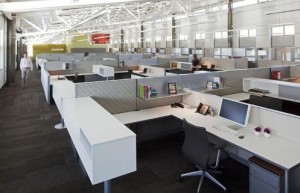 We know too little about quality of life in an indoor environment to be confident that we can make it truly better. Nonetheless, imaginative ideas for buildings that inhale pollution and exhale clean air are being proposed. A coalition by the name of The Healthy Building Network is dubious of such claims.
We know too little about quality of life in an indoor environment to be confident that we can make it truly better. Nonetheless, imaginative ideas for buildings that inhale pollution and exhale clean air are being proposed. A coalition by the name of The Healthy Building Network is dubious of such claims.
Many people and groups want to develop healthy buildings, if that can be realistically defined. However, research is just beginning to examine the diversity of microbes in the great indoors where most of us spend 90% of our time. The built environment surrounding us is a mini-ecosystem of viruses, molds, bacteria, skin flakes, hair, and particulates that we usually just call “dirt.” And we are symbiotic with it.
Studies of indoor ecology are too new to know how to encourage life beneficial to us and to discourage pathogenic critters. However, scientists do prescribe, as the EPA does, action to minimize the growth of molds and microbes. Control temperature, keep it dry, and get the “dirt” out of the building.
Warmth and moisture quickly make an indoor mini-ecosystem blossom into a jungle for breeding pathogens. Cool and dry is easy to understand, but it may cost extra energy, and it’s only less bad. Really good indoor ecology scientists have yet to understand. However, extreme sterility is not the route to take. Several studies are under way.
Dr. Noah Fierer of the University of Colorado leads one of several studies to classify the micro-biota in buildings. Since this has never been studied, every finding adds to knowledge about the huge diversity of micro-inhabitants of buildings. Immediately obvious was that the occupants of a building influence the makeup of this “biome.” Each of us exudes a characteristic “convective plume,” millions of bacteria and other mini-detritus that persist for some time wherever they land.
Fortunately, few microbes are pathogenic. Most are beneficial or harmless, or their role with us is unknown. We live with them all our lives. That’s helpful to keep in mind when discovering for instance, that the mix of microbes on a pillowcase is very similar to the mix on a toilet seat. Both are in contact with skin for lengthy periods.
Long known is that tightly sealed buildings tend to make pathogens hang around longer. No exchanges with outside air help clear them out. In a bygone era, we instinctively opened windows to “get rid of stale air.”
However, the outside environment does not stay outside even a tightly sealed building. People and pets come and go, carrying part of the outdoor biome with them. A dog in the house changes the biome inside it. A suspicion is that a “wilder” indoor biome may have an influence on people that is similar to exposure to an outdoor environment. People that have long lived in the outdoors and around animals develop a different digestive microbiome and stronger immunities.
To this end, another research project called Pathomap intends to map and characterize the microbiome of entire cities, starting with New York City, where rural influences are mostly trucked in. It’s too early to have high confidence in findings. However, the shift in thinking associated with this project is significant.
The objective of this research is as important as any findings from it. Discover how to create and sustain a healthy indoor environment for humans by creating a healthy micro-environment around them. Couple this with the need for quality of life using less energy and water. Then architecture and building maintenance should address a broader range of concerns in a very systematic way.
We do not seem short of technical ideas. Almost daily some company brings out a new device or software to enable low energy, humidity-controlled, smart buildings. In addition to this, for example, “sharklet technology” could reduce the microbial load on high touch surfaces. The human challenge is to integrate all the possibilities into a low energy building with a healthy micro-environment, aware that the inhabitants are part of the environment.
To help get our act together, how about a common vision: a low energy indoor ecology in a “Goldilocks Zone” for humans. However, as illustrated by antibiotic resistant microbes, the microbial world is always changing, offsetting our advances. One-time answers create new problems, so we need on-going learning organizations for large buildings, just as we find when we build a house: the thing is never done, but ever under necessary revision.
